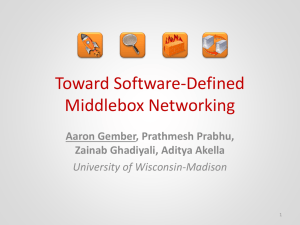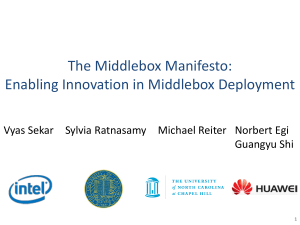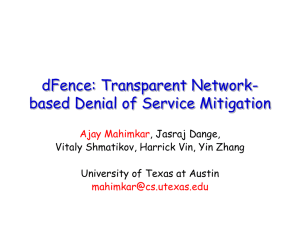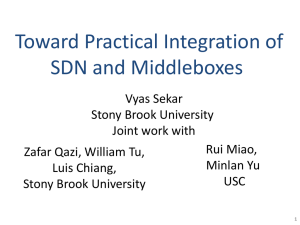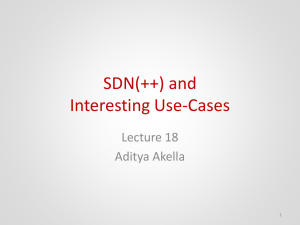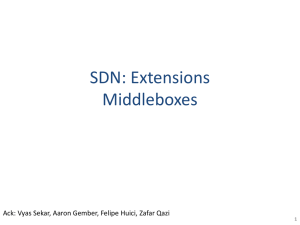BlindBox: Deep Packet Inspection Over Encrypted Traffic
advertisement
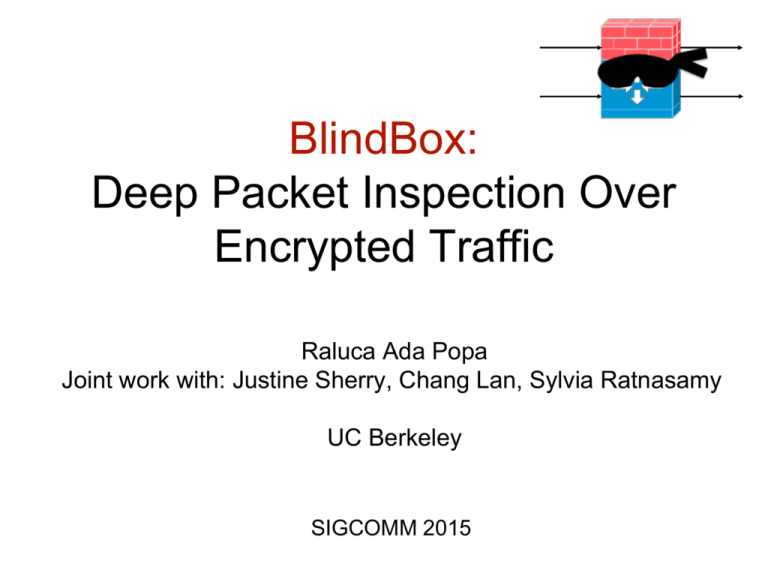
BlindBox:
Deep Packet Inspection Over
Encrypted Traffic
Raluca Ada Popa
Joint work with: Justine Sherry, Chang Lan, Sylvia Ratnasamy
UC Berkeley
SIGCOMM 2015
Deep Packet
Inspection
(DPI)
Intrusion detection/prevention
Exfiltration
In-network devices which
inspect packet payloads to
enforce policies.
Parental filtering
Example: Intrusion prevention
rules
rule generator
rules
ATTACK
HACKS
183237
Alice
ATTAC
K
middlebox
Detect!
Bob
Observation: a lot of traffic
today is sent over https
Problem:
middleboxes cannot inspect
traffic over https
ATTACK
Alice
middlebox
???
Bob
State-of-the-art: man in the
middle attack on SSL
[Huang et al.’14]
fake
certificate
I am Google
SECRE
T
Alice
middlebox
No privacy!
and a lot of other security issues [Jarmoc’12]
Can we achieve both privacy
and payload inspection?
Yes: BlindBox
The first system to enable DPI middleboxes to
inspect traffic without seeing the traffic
Approach
inspect encrypted traffic
without decrypting it!
SECRE
T
Alice
middlebox
Bob
Technical setup
Model
rule generator
rules
Alice
middlebox (MB)
Bob
Threat model
generates rules
rule generator correctly
one endpoint can
misbehave but at least
one endpoint behaves
correctly;
endpoints cannot learn rules
Alice
rules
middlebox (MB)
runs detection functionality correctly
but curious to see traffic content
(honest but curious/passive)
Bob
Goals
1. Strong privacy
2. Practical
well-studied security
guarantee guarantees
network rates are incredibly fast!
(microsec)
3. Wide range of functionality
regexp, scripts
Strawmen:
fully homomorphic or functional
encryption?
[Gentry’09, BSW’11]
Alice
middlebox
Bob
•
Does not fit our threat model
•
Prohibitive performance: IDS detection over a single
packet requires over 1 day*
* based on our experiments using [Katz,
Sahai,Waters’08]
BlindBox’s design
System overview
BBhttps: enhance https
BBhttps
SSL
encrypt
BBhttps
SSL traffic
SSL
decrypt
message
message
BlindBox
encrypt
•
•
encrypted tokens
split in tokens
encrypt each token
•
run detection on
encrypted tokens
SSL remains unchanged.
BlindBox
verify
How do we inspect encrypted
traffic efficiently?
Step1: searchable encryption
scheme
deterministic
schemes
randomized
schemes
packet
inspection
fast
O(log(#rules) *
weak
#bytes/packet)
slow
O(#rules *
[SongWagnerPerrig’00] #bytes/packet)
desired
security
fast
high
high
our new searchable encryption
scheme & detection algorithm
no satisfyin
scheme for
our setting
Our new search scheme
Alice
middlebox
K
AESK(rule)
example message
AES
BBhttps
tokens
example
xample
ample m
mple me
…
Fast encryption:
(salt) ?=AES
salt, AES
only AES! (salt)
AESK(rule)
AESK(token)
But detection is
slow O(#rules *
#tokens)
Desired:
Avoid combining a salt with each rule
Build index on rules
Fast detection protocol
Alice
middlebox
Use a salt schedule:
tokens encrypted tokens
A
EncK(1, A)
B
EncK(1, B)
A
EncK(2, A)
A
EncK(3, A)
Rule index:
precompute tree with salt=1
EncK(1, rule1),
EncK(1, rule2), …
EncK(2, rule2)
rare operation!
For each token, one tree lookup!
O(log #rules * # tokens)
But how does the middlebox
obtainAESK(rule) ?
Alice
K
middlebox
AESK(rule)
Bob
Step 2: BlindBox’s setup
phase
Alice
K
middlebox
have rule wantAESK(rule)
AES
1. Alice sends to MB garbled circuits [Yao’86]
for K()
2. MB runs oblivious transfer [Rabin’81] with Alice to
obtain encoding for rule
AESK(rule)
3. MB evaluates garbled circuit and obtains
Security guarantee
“Principle of least privilege”: the middlebox learns only
byte positions where a rule matches (well-studied
guarantee in the searchable encryption literature)
byte stream
BLACKLIST
match!
ATTACK
HACKS
So far…
complete system for equality matching
exfiltration
parental filtering intrusion prevention (IP
Need support for regular expressions!
How to support regular
expressions?
Rules with regular expressions in
IPS
Snort rule example:
{ content: “malicious string”,
pcre: “/\r\nHost\x3As+[^\r\n]*?[bcdfghjklmnpqrstvwxyz]{5,}[^\r\n]*?\x2Ebiz
[…]
}
•
Rule first matches string by equality
•
Must be highly selective string
New privacy model:
probable cause privacy
Privacy may be lost only if there is a probable cause
If a malicious string matches a
packet, middlebox can decrypt the
packet, but not otherwise.
New encryption scheme for
probable cause
Enc’K(token)
Alice
K
middlebox
AESK(rule)
If token = rule, middlebox obtains
K
Middlebox can run regexp
Rule
{content: “malicious string”,
pcre: “/\r\nHost\…”,
[…]
}
Step 1: match content string on
encrypted traffic
obtain K
decrypt packet
Step 2: run regexp on unencrypted traffic
More details in our paper!
•
Optimizations to reduce bandwidth overhead
•
Details on garbled circuits + oblivious
transfer
•
Support for malicious middlebox
•
Rule generation, regular expressions,
probable cause decryption…
Implementation
•
Endpoints: BBhttps - C library
•
Middlebox: Click framework
Evaluation
functionality
performance
Functionality Evaluation
IDS
Dataset
Without probable
cause
With probable cause
Document
watermarking
100%
100%
Parental filtering
100%
100%
67%
100%
42%
100%
40%
100%
29%
100%
Snort community
(HTTP)
Snort Emerging
Threats (HTTP)
StoneSoft (McAffee)
IDS
LastLine IDS
Performance highlights
•
Three main performance figures:
•
Detection Time: competitive with existing IDSes!
•
•
Transmission Time: practical overhead
•
•
186Mbps with BlindBox (comparable to Snort)
Page load completion time increases by 0.15-1x
Setup Time: not yet competitive
•
1 min for 3000 rules
•
fine for long-lived connections (cloud-enterprise)
Upcoming work: MBArk
Outsourcing middleboxes to the cloud
Support header-based computations over encrypted
data: firewall, NAT, IP forwarder, load balancer, VPN,
IDS, exfiltration
Conclusion
BlindBox is the first system to enable DPI
middleboxes to process traffic without seeing it
•
practical for a class of applications
Thanks!
